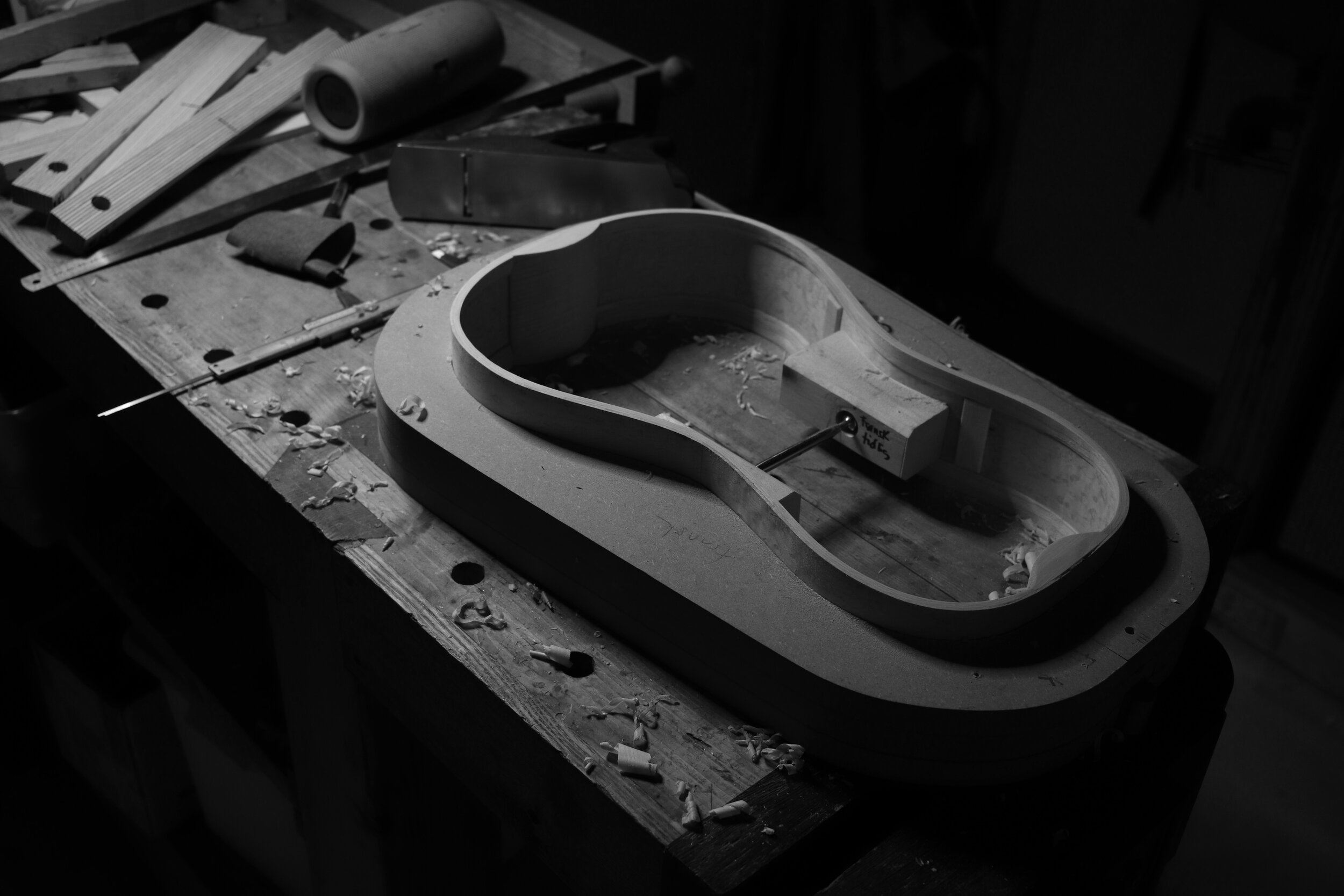A bit of History…
I began my life-long romance with the guitar playing electric guitar during my early teens. Like many at that age, I not only tried to learn the licks and moves, but also spent many hours drawing the guitar of my dreams.
Through my years in high school, I was inclined towards math and physics, and had pretty much decided to choose engineering or IT, but the school rector talked me into choosing architecture and arts instead. The last high school year, with subjects as analytic geometry, art history and design proved to be very meaningful as the years went by.
When I was through with high school, I moved to Montevideo to study fine arts at the University. After several years, I enrolled in the guitar-making course at the National School of Arts and Crafts. The course was just what I needed at the time: the right arena to mix my different interests.
During that same period, I started learning classical guitar technique and interpretation with Maestro Juan Carlos Alves - who also was my Lutherie teacher. In this way, I sought to understand not only the instrument, but also the music and the people it was built for.
In 1999 I graduated a Luthier and kept on building several guitars under the tutelage of my master while I began studying carpentry. In 2002 a friend invited me to move to Norway to work for a while and explore new horizons. The idea of changing scenery was really tempting and I accepted the offer. At last, I got accustomed to the country, its people and language and chose to make it my permanent home.
By 2005 I opened my first shop in Oslo and worked there making classical guitars until my family and I moved to Uruguay on a sabbatical pause in early 2012
We came back to Norway in 2013 and -drawn in part by the beautiful location and the promise of a stable and dry climate- we settled in Hamar, on the eastern shore of Norway’s largest lake. I sat up my basement shop in the following months, acquired new machinery and began planning a move over to electric instruments.
In late 2013 and early 2014, I started developing prototype electric guitars and new tooling and templates. I established my first line of products shortly after.
In early 2015 I traveled to Portland, OR to attend classes with Charles Fox at the American School of Lutherie, where I gathered a wealth of knowledge enough to last me a lifetime, and certainly enough to profoundly transform my work. With a renewed vision, I expanded my design portfolio and took the quality of my instruments to new heights.
From September 2018 to August 2021, I was a Fellow at the Norwegian Crafts Institute. There I did research on romantic guitars and traditional lutherie techniques, aiming to take a more critical approach to my own work.
In 2021 I launched a new classical guitar model and expanded my protfolio to include romantic guitars from different European schools.
My philosophy
I had always tried to dissipate the aura of mysticism that surrounds instrument making. Musicians and makers often like to attribute their instruments metaphysical properties, and this in turn, renders the actual process of making the instruments all the more inaccessible. There are myths, dogmas, secret formulas and rituals, magic... I tried to oppose this, and in an effort to compensate I said things like “this is not alchemy” or “this is just a craft, and guitars are just tools” many, many times...
But this craft is not like other crafts: repeating the same process or formula over and over again doesn’t necessarily yield the same results. And making something that looks perfectly like a guitar may not sound or play well at all. Trees have all had their unique lives and each new wood piece will have specific qualities that we must bow to.
The process of producing sound is as complex as sound itself, and there are too many variables involved to be able to control them all. The results cannot always be measured or quantified, and the judgment passed by the listener will prove to be far from objective.
Nevertheless, through experience and by constantly analyzing, feeling and listening, a luthier develops an unconscious understanding of the wood, of each component and its role. We feel and do without thinking, and our ears, eyes and fingers become our most precious tools. This intuition, this place without words or measures, is where the so-called secrets are, where the magic happens. This very knowledge is the most valuable and at the same time the most difficult to share, and it makes this craft a true art form.
In the beginning, I believed that good instruments were those that posed the fewest obstacles to the player. But with the years I have learned, and now I believe, that truly good instruments are not only good tools that serve the musicians who play them, they are also an active component in their creative process and an essential part of the very fabric of music.



